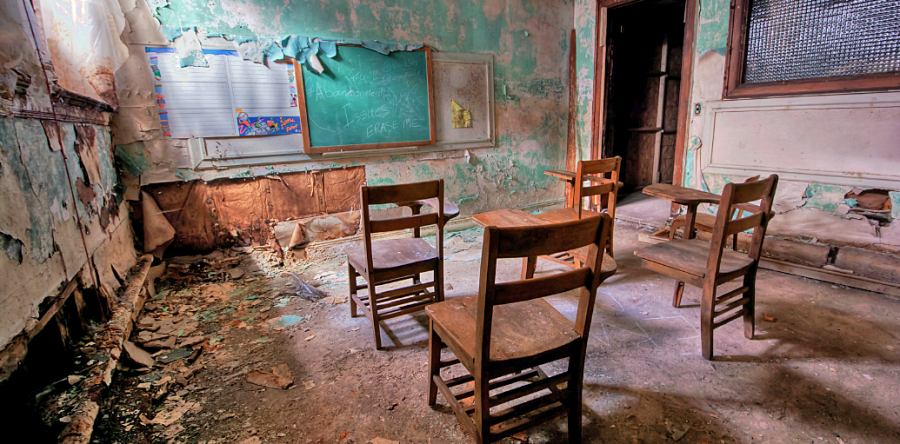School as an Island
We all expect schools and parents to make sure that children’s right to education is met. Things seem clear, but only at the surface. At a closer look, we see that schools and kindergartens are far from having adequate resources and instruments to ensure that vulnerable children have the right to quality education.
Let’s start at the beginning. How do children who are not in school (some of them without identification papers) get enrolled in the education system? And how do they stay in school? Even if teachers identify these children in the community, they do not have the training or the instruments to ensure that these kids will be enrolled. It is normal for teachers not to have these skills, because they are not social workers. We could have the most prepared and motivated teachers, but how can a child succeed if he/she comes to school starving and exhausted from work?
There is a broad spectrum of vulnerabilities. We are talking about children affected by poverty (in Romania, almost half of children are at risk of poverty or social exclusion, according to Eurostat), Roma children, children with disabilities, with special educational needs (S.E.N.), children lacking parental care, children who have abandoned school or were not enrolled in time, children involved in the worst forms of labour, this list can be continued. Most of these vulnerabilities have a profound social cause and require a complex approach, which a school cannot implement on its own, because it is not a social work institution.
At grassroots level (and not only), concepts such as ”multidisciplinary teams”, ”inter-institutional cooperation”, ”consultative community structures” (as long as it means more than meeting in order to sign an attendance list) remain, more often than not, wishful thinking or words taken from laws, strategies or action plans.
Seldom are the examples of real collaboration and prompt, coordinated and efficient intervention between schools and social work institutions. It is disheartening to see exhausted teachers fighting desperately to get vulnerable pupils back to school.
”The social services came … after weeks of complaints and phone calls, they sent someone. We went together, we saw, they completed a social inquiry and left … but, since then, nothing. It’s been more than a month and the final exams are soon. The child is still not coming to school. He will lose this school year and he is a very clever pupil, he could do it. We are losing him!” – Rural school teacher.
The social work institutions are confronted by their own obstacles, such as the shortage and turnover of human resources (particularly among the specialised staff), the underdevelopment of specialised services (including in terms of national coverage), long waiting times between complaints received and action taken, as well as the insufficiency of material resources etc.
The social services network is still poorly developed: there are directorates for social work and child protection services (DGASPC) only in county capitals and in Bucharest, while in the rest of the country there are public social work services (SPAS) – with a chronic personnel deficit and a reduced degree of professionalism (only one out of four employees is a social worker). Moreover, in a third of rural localities and some small cities, there are no such services, the social worker’s responsibilities being simply assigned to existing town hall employees.
”There are no methodologies for evaluating or monitoring the state of different vulnerable groups at a local level, nor are there methodologies for the early detection of people at social risk. (…) Home visits and the identification of cases through fieldwork are seldom part of the current activities of the people with social work responsibilities, who generally are overloaded with the office work of checking files for different social benefits. The referral systems for the most vulnerable groups in need of specialised services are either completely lacking or poorly developed.” – Romanian Government, the National Strategy for Social Inclusion and Poverty Reduction for the period 2015-2020.
In other words, although the solution lies in the communication and cooperation between the social and educational services, in Romania many schools, especially from the rural and small urban areas, are forced to deal in any way they can with nonparticipation, absenteeism and school dropouts. This fact drastically limits the chances of vulnerable children to receive education.
In turn, the institutions in the field of education have to overcome chronic issues – a list which is too long for a member state of the EU (even when this country, compared to the rest, allots the smallest percentage of the GDP to education). I will elaborate a few of these issues further down.
The inclusion of children with special educational needs into the public educational system, in line with the rights of the child and the rights of persons with disabilities, is far from being ensured in an adequate manner, despite the existence of international and national laws, as well as individual intervention plans and other type of planning.
Thus, when schools are not properly adapted and equipped, when teachers are not specially trained and supported, when parents and pupils alike are unprepared for the inclusion of children with special educational needs, shortfalls are frequent and horrifying. Prejudice against and rejection of children with S.E.N. still dominate, and these children are sometimes seen as obstacles in the education of other pupils or in the professional growth of teachers. Moreover, there are cases when, based on the results at the final exams, children with S.E.N. are blamed for damaging the image of their school.
There are issues with adapting the curriculum and the method of examination and evaluation. Rehabilitation services are difficult to access for those outside county capitals or Bucharest. The number of support teachers remains insufficient, and the ones that do exist only have one or two hours per week to spend with each child. Thus the class teachers are forced to handle challenges by themselves.
School counsellors, introduced in schools and kindergartens in order to offer support, could be a valuable resource, both in the case of children with SEN, as well as of vulnerable children exposed to the risk of absenteeism and dropout. School counsellors could also contribute to combating violence against pupils (given that the existence of certain vulnerabilities increases the risk of bullying).
However it would be very difficult, if not impossible, for school counsellors to do their job and to prove that their role does matter when they have less than 180 days at their disposal (the number of days in the school year) to teach the class and to do the identification of needs, prevention and intervention for a minimum of 800 pupils or 400 preschoolers, possibly moving back and forth between multiple schools and kindergartens. The regulations stipulate a minimum of children per counsellor, not a maximum, as needed.
We reach the point where some school units, especially those in isolated communities and sparse villages, do not benefit from counselling services. This fault of logic is obvious, considering that these schools need extra-support in working with vulnerable children. Personally, I never stop marvelling at the fact that, under current legislation, one counsellor would be sufficient for all the pupils of this country.
This provision of children to school counsellor ratio has remained unchanged, despite many opportunities offered by changes to the education law and methodologies of its application. The introduction of the obligation of the school counsellors to teach classes has further reduced the time that they have to do their jobs. On the other hand, this fact also leads to a confusion of professional roles –pupils relate in one way to their teacher (seen as the one who evaluates, gives marks and can bring sanctions), whilst another type of relationship should be established with the school counsellor.
26 years since Romania took on the obligation to respect and ensure all the rights of each and every child (comprised in the UN Convention on the Rights of the Child), we find way too many situations in which it is still unknown how and what needs to be done in order to fulfil this obligation, nor who are those who should take certain responsibilities.
Thus, we see responsibilities not upheld or unrealistically distributed (for example the teachers who have more children with S.E.N. in a class of over 30 pupils, unrealistic ratios for school counsellors, insufficient time spent with the support teacher). We see confusion between professional roles, weak inter-institutional collaborations, and insufficient budgetary and human resources allocations.
Inside this gloomy picture, there are some rays of sunshine. There are good practices which have proved their efficiency in time, which can be replicated at a national level in order to ensure vulnerable children the right to quality education. We have legal obligations, strategies and plans nicely formulated, but it would be even better if these were applied from the biggest cities to the farthest hamlets, receiving the necessary resources and coordination.
We don’t need to reinvent the wheel, but to be willing and have common sense – the school teacher should not be asked to fulfil the role of the social worker; the social worker should be present in each community and should be specialised (not the cadastre engineer, nor the town hall secretary, as happens in some localities); the school counsellors should be allowed to do their job, not asked to teach. All these professionals need to be supported and treated with respect, not brought to the point of powerlessness and resignation.
New opportunities for European funds, which were secured by the Romanian Government within the Operational Programme Human Capital (PO CU), bring a shred of hope, especially programmes such as “School for Everyone”, “Motivated Teachers in Disadvantaged Schools”, and “The Reduction of the Number of People Living in Poverty and Social Exclusion”.
These funding programmes represent a good opportunity to stimulate multi-disciplinary interventions (through a collaboration between school and other local institutions and stakeholders), to attract and maintain qualified human resources in schools (implicitly through training and mentoring), and to develop social services at community level.
However, in the end, the projects financed through these programs will address a limited number of schools and communities. In all this time, the other school units, not included in these projects, will be left on their isolated island, to continue to handle the vast range of complex problems as they can, with improvisations and half measures. Nonetheless, for real results it is necessary to give up this shambolic patchwork system.
At the end of the day, the right to quality education is the same for all children.
Mihaela Manole holds a BA in Sociologyy and Social Work and she has been working in the field of education and children’s rights for over ten years, as project manager with the Save the Children organization. Mihaela was an intern with the EU Fundamental Rights Agency and then a member of the FRANET experts’ team, participating in the collection of relevant data and writing reports on the human rights situation in Romania.














0 Responses